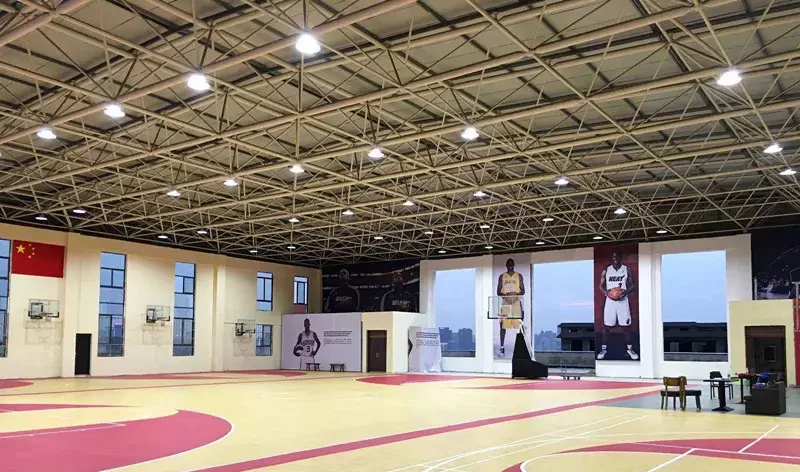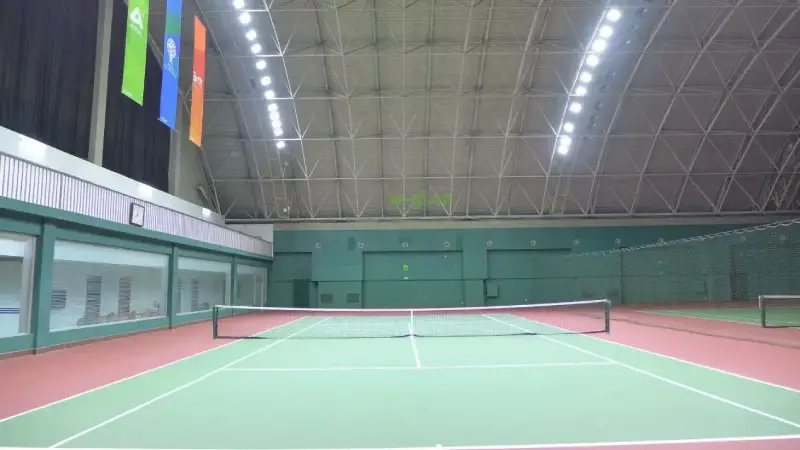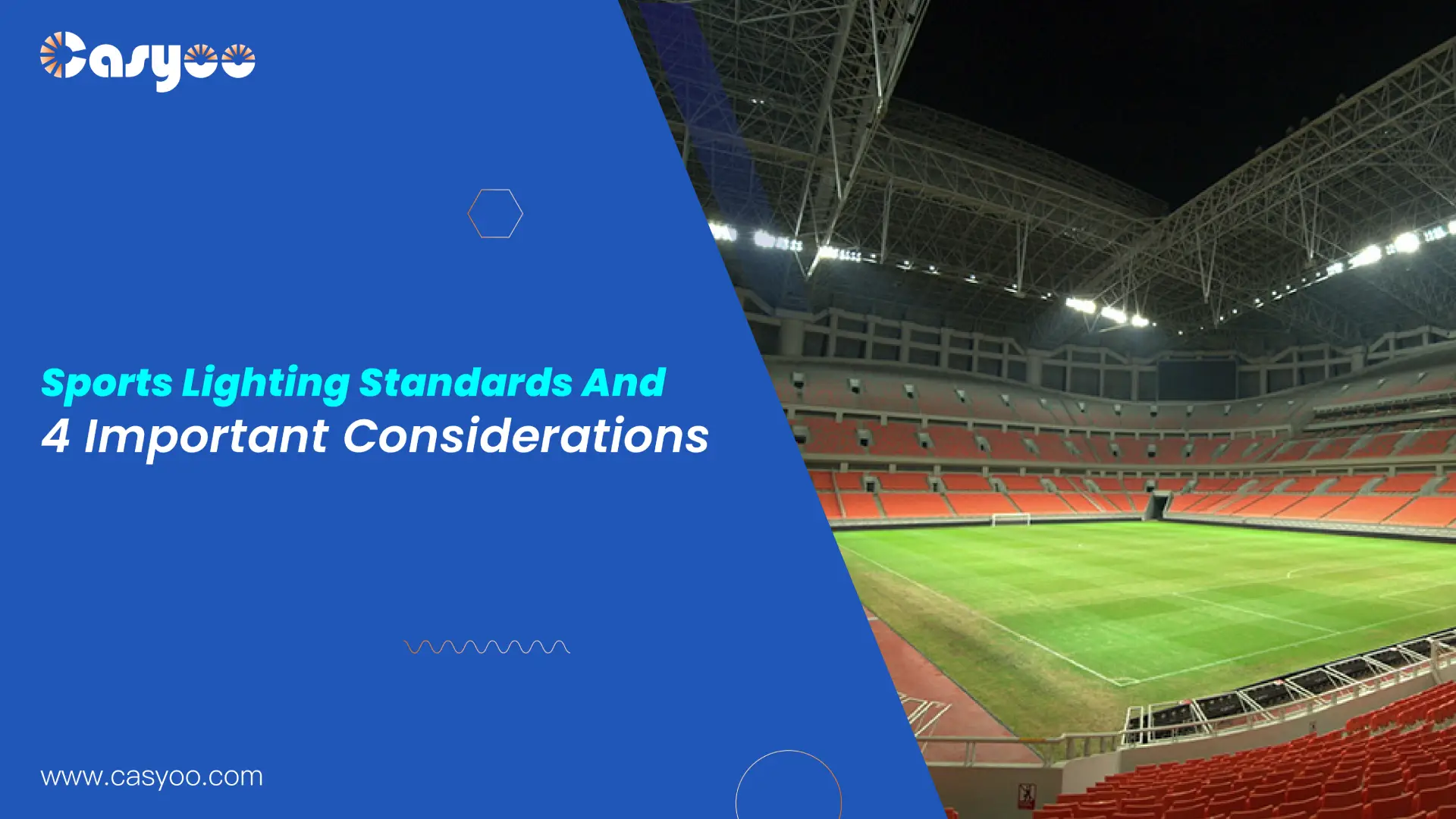Want to know the authoritative lighting standards for football fields/tennis courts/basketball courts/track and field venues/swimming pools/baseball fields/golf courses? Read our passage for information about sports lighting standards! And knowing the standards is only the first step in sports lighting design. A sports lighting solution cannot be perfect enough without careful consideration of the types and arrangements of the lights, glare control, methods of controlling the lights, and so on. Let’s dive in to learn more about sports lighting!
Organizations that set standards for sports events
The lighting of multi-functional indoor sports venues: GAISF, EBU. This standard introduces the lighting requirements for high-definition color television broadcast (HDTV).
Lighting of sports events with color television broadcast and film record: CIE, such as CIE Document No.83. The focus of CIE documents is on the lighting requirements for televised games. It also explains the differences between television photography and film photography.
Photometric measurement standards: International Commission on Illumination (CIE), such as CIE document No.67. CIE has established standard procedures for calculating, measuring, and reporting lighting characteristics for indoor and outdoor sports lighting.
The lighting standards for specific sports are formulated by the corresponding international organizations. For example, FIFA published the standards for football pitch lighting. For track and field venues, the International Association of Athletics Federations (IAAF) specifies the lighting requirements. And the International Tennis Federation (ITF) sets the lighting requirements for tennis courts. The lighting standards for basketball courts are formulated by the International Basketball Federation (FIBA), which issued the lighting standards for basketball court lighting. Let’s get to know the specific standards in the following paragraphs.
Football pitch lighting standards
| Class | Calculation towards | Horizental illuminance | Vertical illuminance | Properties of lamps | |||||||||
| Eh | Uniformity | Ev | Uniformity | Color temperature | Color rendering | ||||||||
| lx | U1 | U2 | lx | U1 | U2 | Tcp (K) | Ra | ||||||
| Non-televised | Ⅰ | Training and recreation | / | 200 | / | 0.5 | / | >4000 | ≥65 | ||||
| Ⅱ | League and club | 500 | 0.6 | >4000 | ≥65 | ||||||||
| Ⅲ | National and international games | 750 | 0.7 | >4000 | ≥65 | ||||||||
| Televised | Ⅳ | Field aiming national | Fixed camera | 2500 | 0.6 | 0.8 | 2000 | 0.5 | 0.65 | >4000 | ≥65 | ||
| Field camera | 1400 | 0.35 | 0.6 | >4000 | ≥65 | ||||||||
| Ⅴ | Field aiming international | Fixed camera | 3500 | 0.6 | 0.8 | 2000 | 0.6 | 0.7 | >4000 | ≥65 | |||
| Mobile camera | 1800 | 0.4 | 0.65 | >4000 | ≥65 | ||||||||
Note:
- The values in the table are maintenance illuminance values.
- Ev: The vertical illuminance towards a field camera or fixed camera. Handheld cameras and jib cameras are collectively referred to as field cameras.
- The glare value in each level of field should be GR≤50.
- The maintenance coefficient should not be less than 0.7.
- Constant lumen technology is recommended.
Track and field venues lighting standards
| Class | Calculation towards | Horizental illuminance | Vertical illuminance | Properties of lamps | |||||||
| Eh | Uniformity | Ev | Uniformity | Color temperature | Color rendering | ||||||
| lx | U1 | U2 | lx | U1 | U2 | Tcp (K) | Ra | ||||
| Non-televised | Ⅰ | Training and recreation | / | 75 | 0.3 | 0.5 | / | >4000 | ≥65 | ||
| Ⅱ | League and club | 200 | 0.4 | 0.6 | >4000 | ≥65 | |||||
| Ⅲ | National and international games | 500 | 0.5 | 0.7 | >4000 | ≥80 | |||||
| Televised | Ⅳ | Field aiming national | Fixed camera | / | 1000 | 0.4 | 0.6 | >4000 | ≥80 | ||
| Ⅴ | Field aiming international | Slow motion camera | 1800 | 0.5 | 0.7 | >5500 | ≥90 | ||||
| Fixed camera | 1400 | 0.5 | 0.7 | >5500 | ≥90 | ||||||
| mobile camera | 1000 | 0.3 | 0.5 | >5500 | ≥90 | ||||||
| Finish line camera | 2000 | ||||||||||
Note:
- The glare level of venue should be GR≤50;
- For the finish line camera, U1 and U2 within 5m before and after the finish line should not be less than 0.9.
- PPA: Principal Playing Area; TPA: Total Playing Area
Tennis court lighting standards
| Tennis CourtLighting Standards For Entertainment And Fitness | ||||||||||
| Classification | Eh (lx) | Eh Uniformity | GR max | Ra | TCP (k) | |||||
| U1 | U2 | |||||||||
| PPA | TPA | PPA | TPA | PPA | TPA | |||||
| Outdoor TennisCourt | Standard | 150 | 125 | 0.3 | 0.2 | 0.6 | 0.5 | 50 | ≥65 | 4000 |
| High Grade | 300 | 250 | 0.3 | 0.2 | 0.6 | 0.5 | 50 | ≥65 | 4000 | |
| Indoor TennisCourt | Standard | 250 | 200 | 0.3 | 0.2 | 0.6 | 0.5 | 50 | ≥65 | 4000 |
| High Grade | 500 | 400 | 0.3 | 0.2 | 0.6 | 0.5 | 50 | ≥65 | 4000 | |
| Outdoor TennisCourt Lighting Standard | |||||||||||||||
| Classification | Eh (lx) | Ev (lx) | Eh Uniformity | Ev Uniformity | Ra | TCP (K) | |||||||||
| U1 | U2 | U1 | U2 | ||||||||||||
| PPA | TPA | PPA | TPA | PPA | TPA | PPA | TPA | PPA | TPA | PPA | TPA | ||||
| Training | 250 | 200 | - | - | 0.4 | 0.3 | 0.6 | 0.5 | - | - | - | - | ≥65 | 4000 | |
| Domestic competition | 500 | 400 | - | - | 0.4 | 0.3 | 0.6 | 0.5 | - | - | - | - | ≥80 | 4000 | |
| International competition | 750 | 600 | - | - | 0.4 | 0.3 | 0.6 | 0.5 | - | - | - | - | ≥80 | 4000 | |
| Camera distance | 25m | - | - | 1000 | 700 | 0.5 | 0.3 | 0.6 | 0.5 | 0.5 | 0.3 | 0.6 | 0.5 | ≥80 | 4000/ 5000 |
| 75m | - | - | 1400 | 1000 | 0.5 | 0.3 | 0.6 | 0.5 | 0.5 | 0.3 | 0.6 | 0.5 | ≥80 | 4000/ 5000 | |
| HDTV | - | - | 2500 | 1750 | 0.7 | 0.6 | 0.8 | 0.7 | 0.7 | 0.6 | 0.8 | 0.7 | ≥90 | 4000/ 5500 | |
Note:
- GR≤50. When onTV/HDTV/movie broadcast, Ra≥90 is better. The color temperature should keep at 5500K.
Basketball courts lighting standards
The newest basketball equipment rules published by FIBA in 2022 show the standards as below:
| EC: Main camera illuminance | EV: Vertical illuminance(alldirections) | EH: Horizontal illuminance | ||||||||
| Avg(lux) | Min/Max | Min/Avg | Avg(lux) | Min/Max | Min/Avg | Min/Max 4x directions | Avg(lux) | Min/Max | Min/Avg | |
| PPA | 2000 | 0.7 | 0.8 | 1700 | 0.7 | 0.8 | 0.6 | 1500-3000 | 0.7 | 0.8 |
| TPA | 2000 | 0.6 | 0.7 | 1700 | 0.6 | 0.7 | 0.6 | 1500-3000 | 0.6 | 0.7 |
Swimming pool lighting standards
| Area | Illuminance(lx) | Illumination uniformity (minimum value) | ||||
| Ev-cam-min | Eh-ave | Horizontal | Vertical | |||
| Emin/Emax | Emin/Eave | Emin/Emax | Emin/Eave | |||
| Competition venue | 1400 | See “Ratio” below | 0.7 | 0.8 | 0.6 | 0.7 |
| Competition area | 1400 | 0.6 | 0.7 | 0.4 | 0.6 | |
| Isolation area | / | 0.4 | 0.6 | |||
| Audience seats (Camera C1) | See “Ratio” below | / | 0.3 | 0.5 | ||
| Ratio | ||||||
| Eh-ave-FOP/Ev-ave-Cam-FOP | ≥0.75 and ≤15 | |||||
| Eh-ave-deck/Ev-ave-Cam-deck | ≥0.5 and ≤2.0 | |||||
| Ratio of the minimum and maximum values of Ev on the four planes of the FOP calculation point | ≥0.6 | |||||
| Ev-ave-spec/Ev-ave-Cam-FOP | ≥0.1 and ≤0.25 | |||||
| Ev-min-TRZ | ≥Ev-ave-C#1-FOP | |||||
| Uniformity gradient (maximum value) | ||||||
| UG-FOP(2m and 1m grid) | ≤20% | |||||
| UG-deck(4m grid) | ≤10% | |||||
| UG-auditorium (facing camera 1) | ≤20% | |||||
| Light sourcerequirement | ||||||
| CRI Ra | ≥90 | |||||
| Tk | 5600K | |||||
| Glare GR | ||||||
| Fixed camera | ≤40 | |||||
Note:
FOP: Field of play; UG: Uniformity Gradient
Baseball field lighting standards
Please refer to Effective Baseball Field Lighting Solutions: All You Need to Know.
Golf course lighting standards
Please refer to Best Golf Course Lighting Design for Nighttime Play.
4 important considerations of sports lighting
1. Lamp arrangement
| Classifications | Lighting method | Features | Suitable applications |
| Direct lighting | Lighting from above | Low vertical illumination, low glare, uniform illumination, low equipment cost | Comprehensive gymnasium, boxing, gymnastics, skills, wrestling, training hall |
| Lighting from two sides | When used for ball sports with a certain direction, it has low glare, high vertical illumination and strong three-dimensional effect. | Ball games, gymnastics, swimming, water polo | |
| Lighting from one side+above | Uniform illumination, low glare, high vertical illumination, low equipment cost | Gymnasium, gymnastics, boxing, wrestling | |
| Indirect lighting | Lighting towards the two sides | Soft light, low glare, high equipment cost | Ball games, gymnastics, swimming, water polo |
| Lighting from below | Bright light, low glare, high equipment cost | Ball games, gymnastics, swimming, water polo |


2. Choice of the light sources
LED lights
LED lamps have been widely used in stadium lighting. It can provide efficient and uniform lighting, which can meet the requirements of illuminance and uniformity in international standards. In addition, the angle of LED lamps can be adjusted according to the venue shape and lighting requirements. It is optional to change the color of the LED lights to match the venue’s color.
Metal halide lamps
Metal halide lamps have high brightness and high CRI and can be used in stadium lighting. They can reduce shadows and allow players and spectators to watch the game better. Metal halide lamps are cheaper but have lower efficiency and a shorter lifespan compared with LED lamps. At the same time, the angle of metal halide lamps cannot be adjusted.
Sodium lamps
Sodium lamps are traditional lamps that emit a yellowish light. They are not suitable for lighting competitions because they cannot meet the requirements of color temperature and color rendering index in international standards.
3. Preventing glare
Strong glare will make the lighting disharmonious, make people feel uncomfortable, and cause a decrease in their observation ability. By carefully adjusting the installation position and aiming point of the lamp, you can reduce the glare to a minimum. After installing the lamp, select multiple glare test points for testing to ensure that the glare value meets international requirements.
4. Ways of control
The task of lighting control is to realize lighting solutions for various sports games under the given lighting arrangement. Earlier stadiums mostly used relays, contactors, or thyristors to realize lighting control.
While controlling, the staff can preset common scene lighting modes through the console program, such as preparation, TV broadcast games, basketball games, volleyball games, badminton games, general games, training, etc. They can also preset new scene lighting modes or adjust existing scene lighting modes through the computer.
According to different sports lighting standards, staff can directly turn on, change, or turn off the preset scene lighting through the console. They can also control the buttons on the panel to achieve one-touch lighting changes.
Conclusion
In this passage, we have introduced the organizations that set the lighting standards for different games, the standards for some of the popular sports, and what you need to consider. If you need more support, feel free to contact us and ask more about sports lighting.




